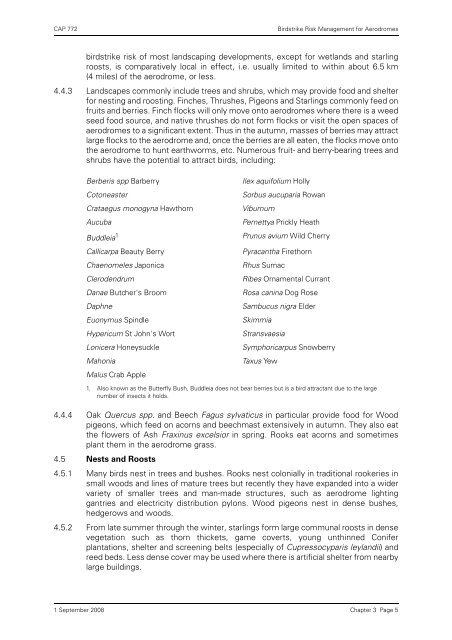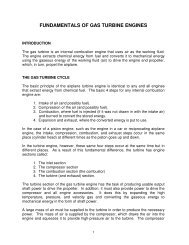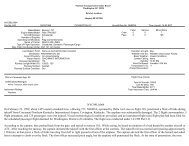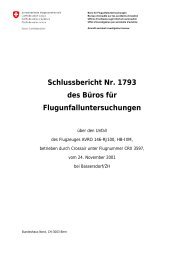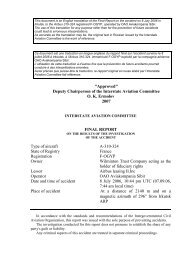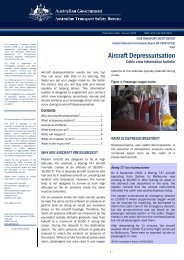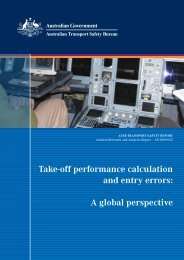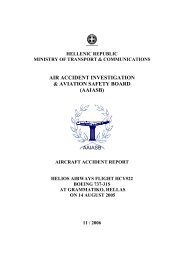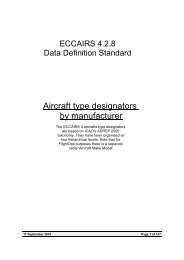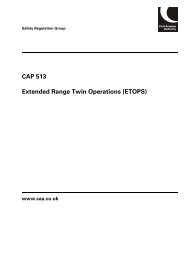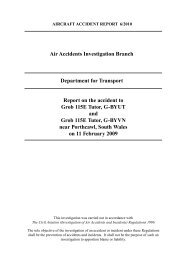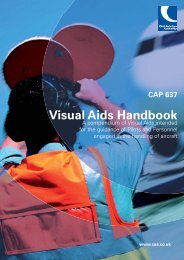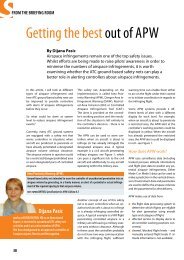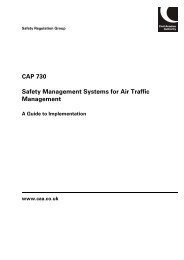CAP 772 - Birdstrike Risk Management for Aerodromes - SKYbrary
CAP 772 - Birdstrike Risk Management for Aerodromes - SKYbrary
CAP 772 - Birdstrike Risk Management for Aerodromes - SKYbrary
You also want an ePaper? Increase the reach of your titles
YUMPU automatically turns print PDFs into web optimized ePapers that Google loves.
<strong>CAP</strong> <strong>772</strong> <strong>Birdstrike</strong> <strong>Risk</strong> <strong>Management</strong> <strong>for</strong> <strong>Aerodromes</strong><br />
birdstrike risk of most landscaping developments, except <strong>for</strong> wetlands and starling<br />
roosts, is comparatively local in effect, i.e. usually limited to within about 6.5 km<br />
(4 miles) of the aerodrome, or less.<br />
4.4.3 Landscapes commonly include trees and shrubs, which may provide food and shelter<br />
<strong>for</strong> nesting and roosting. Finches, Thrushes, Pigeons and Starlings commonly feed on<br />
fruits and berries. Finch flocks will only move onto aerodromes where there is a weed<br />
seed food source, and native thrushes do not <strong>for</strong>m flocks or visit the open spaces of<br />
aerodromes to a significant extent. Thus in the autumn, masses of berries may attract<br />
large flocks to the aerodrome and, once the berries are all eaten, the flocks move onto<br />
the aerodrome to hunt earthworms, etc. Numerous fruit- and berry-bearing trees and<br />
shrubs have the potential to attract birds, including:<br />
Berberis spp Barberry Ilex aquifolium Holly<br />
Cotoneaster Sorbus aucuparia Rowan<br />
Crataegus monogyna Hawthorn Viburnum<br />
Aucuba Pernettya Prickly Heath<br />
Buddleia 1<br />
Prunus avium Wild Cherry<br />
Callicarpa Beauty Berry Pyracantha Firethorn<br />
Chaenomeles Japonica Rhus Sumac<br />
Clerodendrum Ribes Ornamental Currant<br />
Danae Butcher's Broom Rosa canina Dog Rose<br />
Daphne Sambucus nigra Elder<br />
Euonymus Spindle Skimmia<br />
Hypericum St John's Wort Stransvaesia<br />
Lonicera Honeysuckle Symphoricarpus Snowberry<br />
Mahonia<br />
Malus Crab Apple<br />
Taxus Yew<br />
1. Also known as the Butterfly Bush, Buddleia does not bear berries but is a bird attractant due to the large<br />
number of insects it holds.<br />
4.4.4 Oak Quercus spp. and Beech Fagus sylvaticus in particular provide food <strong>for</strong> Wood<br />
pigeons, which feed on acorns and beechmast extensively in autumn. They also eat<br />
the flowers of Ash Fraxinus excelsior in spring. Rooks eat acorns and sometimes<br />
plant them in the aerodrome grass.<br />
4.5 Nests and Roosts<br />
4.5.1 Many birds nest in trees and bushes. Rooks nest colonially in traditional rookeries in<br />
small woods and lines of mature trees but recently they have expanded into a wider<br />
variety of smaller trees and man-made structures, such as aerodrome lighting<br />
gantries and electricity distribution pylons. Wood pigeons nest in dense bushes,<br />
hedgerows and woods.<br />
4.5.2 From late summer through the winter, starlings <strong>for</strong>m large communal roosts in dense<br />
vegetation such as thorn thickets, game coverts, young unthinned Conifer<br />
plantations, shelter and screening belts (especially of Cupressocyparis leylandii) and<br />
reed beds. Less dense cover may be used where there is artificial shelter from nearby<br />
large buildings.<br />
1 September 2008<br />
Chapter 3 Page 5


